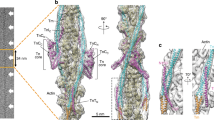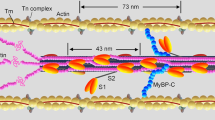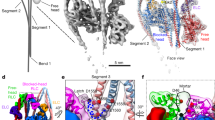Abstract
Contraction of muscle involves the cyclic interaction of myosin heads on the thick filaments with actin subunits in the thin filaments1. Muscles relax when this interaction is blocked by molecular switches on either or both filaments2. Insight into the relaxed (switched OFF) structure of myosin has come from electron microscopic studies of smooth muscle myosin molecules, which are regulated by phosphorylation. These studies suggest that the OFF state is achieved by an asymmetric, intramolecular interaction between the actin-binding region of one head and the converter region of the other, switching both heads off3. Although this is a plausible model for relaxation based on isolated myosin molecules, it does not reveal whether this structure is present in native myosin filaments. Here we analyse the structure of a phosphorylation-regulated striated muscle thick filament using cryo-electron microscopy. Three-dimensional reconstruction and atomic fitting studies suggest that the ‘interacting-head’ structure is also present in the filament, and that it may underlie the relaxed state of thick filaments in both smooth and myosin-regulated striated muscles over a wide range of species.
This is a preview of subscription content, access via your institution
Access options
Subscribe to this journal
Receive 51 print issues and online access
$199.00 per year
only $3.90 per issue
Buy this article
- Purchase on Springer Link
- Instant access to full article PDF
Prices may be subject to local taxes which are calculated during checkout





Similar content being viewed by others
References
Geeves, M. A. & Holmes, K. C. Structural mechanism of muscle contraction. Annu. Rev. Biochem. 68, 687–728 (1999)
Lehman, W. & Szent-Györgyi, A. G. Regulation of muscular contraction. Distribution of actin control and myosin control in the animal kingdom. J. Gen. Physiol. 66, 1–30 (1975)
Wendt, T., Taylor, D., Trybus, K. M. & Taylor, K. Three-dimensional image reconstruction of dephosphorylated smooth muscle heavy meromyosin reveals asymmetry in the interaction between myosin heads and placement of subfragment 2. Proc. Natl Acad. Sci. USA 98, 4361–4366 (2001)
Craig, R. & Padrón, R. in Myology (eds Engel, A. G. & Franzini-Armstrong, C.) 129–166 (McGraw-Hill, New York, 2004)
Huxley, H. E. & Brown, W. The low-angle x-ray diagram of vertebrate striated muscle and its behaviour during contraction and rigor. J. Mol. Biol. 30, 383–434 (1967)
Wray, J. S., Vibert, P. J. & Cohen, C. Diversity of cross-bridge configurations in invertebrate muscles. Nature 257, 561–564 (1975)
Crowther, R. A., Padrón, R. & Craig, R. Arrangement of the heads of myosin in relaxed thick filaments from tarantula muscle. J. Mol. Biol. 184, 429–439 (1985)
Offer, G., Knight, P. J., Burgess, S. A., Alamo, L. & Padrón, R. A new model for the surface arrangement of myosin molecules in tarantula thick filaments. J. Mol. Biol. 298, 239–260 (2000)
Stewart, M., Kensler, R. W. & Levine, R. J. Three-dimensional reconstruction of thick filaments from Limulus and scorpion muscle. J. Cell Biol. 101, 402–411 (1985)
Stewart, M. & Kensler, R. W. Arrangement of myosin heads in relaxed thick filaments from frog skeletal muscle. J. Mol. Biol. 192, 831–851 (1986)
Vibert, P. Helical reconstruction of frozen-hydrated scallop myosin filaments. J. Mol. Biol. 223, 661–671 (1992)
Eakins, F., AL-Khayat, H. A., Kensler, R. W., Morris, E. P. & Squire, J. M. 3D Structure of fish muscle myosin filaments. J. Struct. Biol. 137, 154–163 (2002)
Egelman, E. H. A robust algorithm for the reconstruction of helical filaments using single-particle methods. Ultramicroscopy 85, 225–234 (2000)
Wray, J. S. Structure of the backbone in myosin filaments of muscle. Nature 277, 37–40 (1979)
Liu, J., Wendt, T., Taylor, D. & Taylor, K. Refined model of the 10S conformation of smooth muscle myosin by cryo-electron microscopy 3D image reconstruction. J. Mol. Biol. 329, 963–972 (2003)
Burgess, S. A., Walker, M. L., White, H. D. & Trinick, J. Flexibility within myosin heads revealed by negative stain and single-particle analysis. J. Cell Biol. 139, 675–681 (1997)
Suzuki, H., Stafford, W. F. III, Slayter, H. S. & Seidel, J. C. A conformational transition in gizzard heavy meromyosin involving the head-tail junction, resulting in changes in sedimentation coefficient, ATPase activity, and orientation of heads. J. Biol. Chem. 260, 14810–14817 (1985)
Burgess, S. A. et al. Structure of smooth muscle myosin in the switched-off state. Biophys. J. 82, 356a (2002)
Jung, H. et al. Comparative studies of the folded structures of scallop striated and vertebrate smooth muscle myosins. Biophys. J. 86, 403a (2004)
Stafford, W. F. et al. Calcium-dependent structural changes in scallop heavy meromyosin. J. Mol. Biol. 307, 137–147 (2001)
Trybus, K. M., Freyzon, Y., Faust, L. Z. & Sweeney, H. L. Spare the rod, spoil the regulation: necessity for a myosin rod. Proc. Natl Acad. Sci. USA 94, 48–52 (1997)
Rovner, A. S. A long, weakly charged actin-binding loop is required for phosphorylation-dependent regulation of smooth muscle myosin. J. Biol. Chem. 273, 27939–27944 (1998)
Trybus, K. M., Naroditskaya, V. & Sweeney, H. L. The light chain-binding domain of the smooth muscle myosin heavy chain is not the only determinant of regulation. J. Biol. Chem. 273, 18423–18428 (1998)
Sellers, J. R. Phosphorylation-dependent regulation of Limulus myosin. J. Biol. Chem. 256, 9274–9278 (1981)
Sellers, J. R. Regulation of cytoplasmic and smooth muscle myosin. Curr. Opin. Cell Biol. 3, 98–104 (1991)
Craig, R., Padrón, R. & Kendrick-Jones, J. Structural changes accompanying phosphorylation of tarantula muscle myosin filaments. J. Cell Biol. 105, 1319–1327 (1987)
Levine, R. J., Kensler, R. W., Yang, Z., Stull, J. T. & Sweeney, H. L. Myosin light chain phosphorylation affects the structure of rabbit skeletal muscle thick filaments. Biophys. J. 71, 898–907 (1996)
Hidalgo, C., Padrón, R., Horowitz, R., Zhao, F. Q. & Craig, R. Purification of native myosin filaments from muscle. Biophys. J. 81, 2817–2826 (2001)
Frank, J. et al. SPIDER and WEB: processing and visualization of images in 3D electron microscopy and related fields. J. Struct. Biol. 116, 190–199 (1996)
Pettersen, E. F. et al. UCSF Chimera–a visualization system for exploratory research and analysis. J. Comput. Chem. 25, 1605–1612 (2004)
Acknowledgements
We thank R. Horowitz, W. Lehman and A. Pirani for their help in this work. Support was provided by grants from the National Institutes of Health to R.C. and to E.H.E., an International Research Scholar grant from the Howard Hughes Medical Institute to R.P. and a grant from the National Fund for Science, Technology and Innovation (FONACIT, MCT) to R.P. Electron microscopy was carried out in the Core Electron Microscopy Facility of the University of Massachusetts Medical School, supported in part by grants from the NIH. Molecular graphics images were produced using the UCSF Chimera package from the Computer Graphics Laboratory, University of California, San Francisco, supported by a grant from the NIH.
Author information
Authors and Affiliations
Corresponding author
Ethics declarations
Competing interests
Reprints and permissions information is available at npg.nature.com/reprintsandpermissions. The authors declare no competing financial interests.
Supplementary information
Supplementary Figure S1
Longitudinal view of reconstruction density seen in projection, demonstrating arrowheads (cf. Fig. 1a of paper) (DOC 119 kb)
Supplementary Figure S2
Longitudinal surface view of reconstruction, showing how the transverse view in Fig. 2a of paper is obtained (see Supplementary Movies S2 and S3). (DOC 158 kb)
Supplementary Figure S3
Transverse view of reconstruction seen in projection, demonstrating high density of subfilaments and low density of filament core (cf. Fig. 2b of paper). (DOC 115 kb)
Supplementary Movie S1
Movie of longitudinal view of reconstruction rotated around long axis of filament (cf. Fig. 1c of paper). (MOV 3182 kb)
Supplementary Movie S2
Movie showing how longitudinal view of reconstruction transforms into transverse view seen in Fig. 2a of paper. (MOV 6593 kb)
Supplementary Movie S3
This movie shows how portions of different crowns contribute to the transverse view of the reconstruction containing a single 14.5 nm repeat seen in Fig. 2a of paper. (MOV 2019 kb)
Supplementary Movie S4
This movie provides a three-dimensional perspective on the fitting of the modified smooth muscle HMM atomic structure into the J-motif of the filament reconstruction (cf. Fig. 3a of paper). (MOV 4205 kb)
Supplementary Movie S5
This movie shows different views of the space filling atomic model of PDB 1i84 after modification to fit the "J" motif of the reconstruction (cf. Figs 3b and 5a of paper). (MOV 8291 kb)
Supplementary Movie S6
Movie showing how S2 fits into the reconstruction (cf. Fig. 4 of paper). (MOV 7493 kb)
Supplementary Movie Legends
Text to accompany the above Supplementary Movies. (DOC 33 kb)
Rights and permissions
About this article
Cite this article
Woodhead, J., Zhao, FQ., Craig, R. et al. Atomic model of a myosin filament in the relaxed state. Nature 436, 1195–1199 (2005). https://doi.org/10.1038/nature03920
Received:
Accepted:
Issue Date:
DOI: https://doi.org/10.1038/nature03920
This article is cited by
-
GPR65 inhibits human trophoblast cell adhesion through upregulation of MYLK and downregulation of fibronectin via cAMP-ERK signaling in a low pH environment
Cell Communication and Signaling (2023)
-
Etiology of genetic muscle disorders induced by mutations in fast and slow skeletal MyBP-C paralogs
Experimental & Molecular Medicine (2023)
-
John Squire and the myosin thick filament structure in muscle
Journal of Muscle Research and Cell Motility (2023)
-
Cryo-electron tomography of intact cardiac muscle reveals myosin binding protein-C linking myosin and actin filaments
Journal of Muscle Research and Cell Motility (2023)
-
Targeting the sarcomere in inherited cardiomyopathies
Nature Reviews Cardiology (2022)
Comments
By submitting a comment you agree to abide by our Terms and Community Guidelines. If you find something abusive or that does not comply with our terms or guidelines please flag it as inappropriate.



